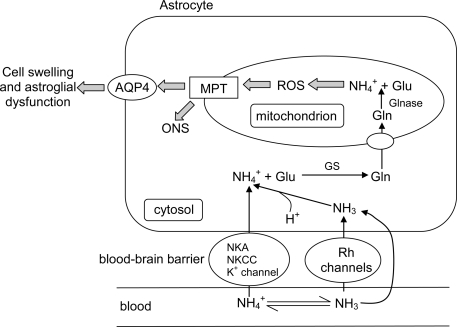Figure 2.
A hypothetical scheme of ammonia-induced astrocyte swelling resulting from (a) the permeation of NH3 and through the blood–brain barrier with or without the aid of transport proteins (NKA, Na+/K+-ATPase; NKCC, Na+:K+:2Cl−-cotransporter; Rh channels, Rhesus glycoprotein channels) from the blood to the brain, (b) an increase in glutamine (Gln) synthesis from and glutamate (Glu) catalyzed by glutamine synthetase (GS) in the cytosol, (c) the entry of Gln into the mitochondria, (d) the breakdown of Gln by mitochondrial glutaminase (Glnase) and the release of in the mitochondrial matrix, (e) an increase in the production of reactive oxygen species (ROS), (f) the induction of mitochondrial permeability transition (MPT), (g) the occurrence of oxidative/nitrosative stress (ONS) in the cell, and (h) the activation of aquaporin channels (e.g., AQP4), leading to the influx of water and resulting in swelling and astroglial dysfunction.

